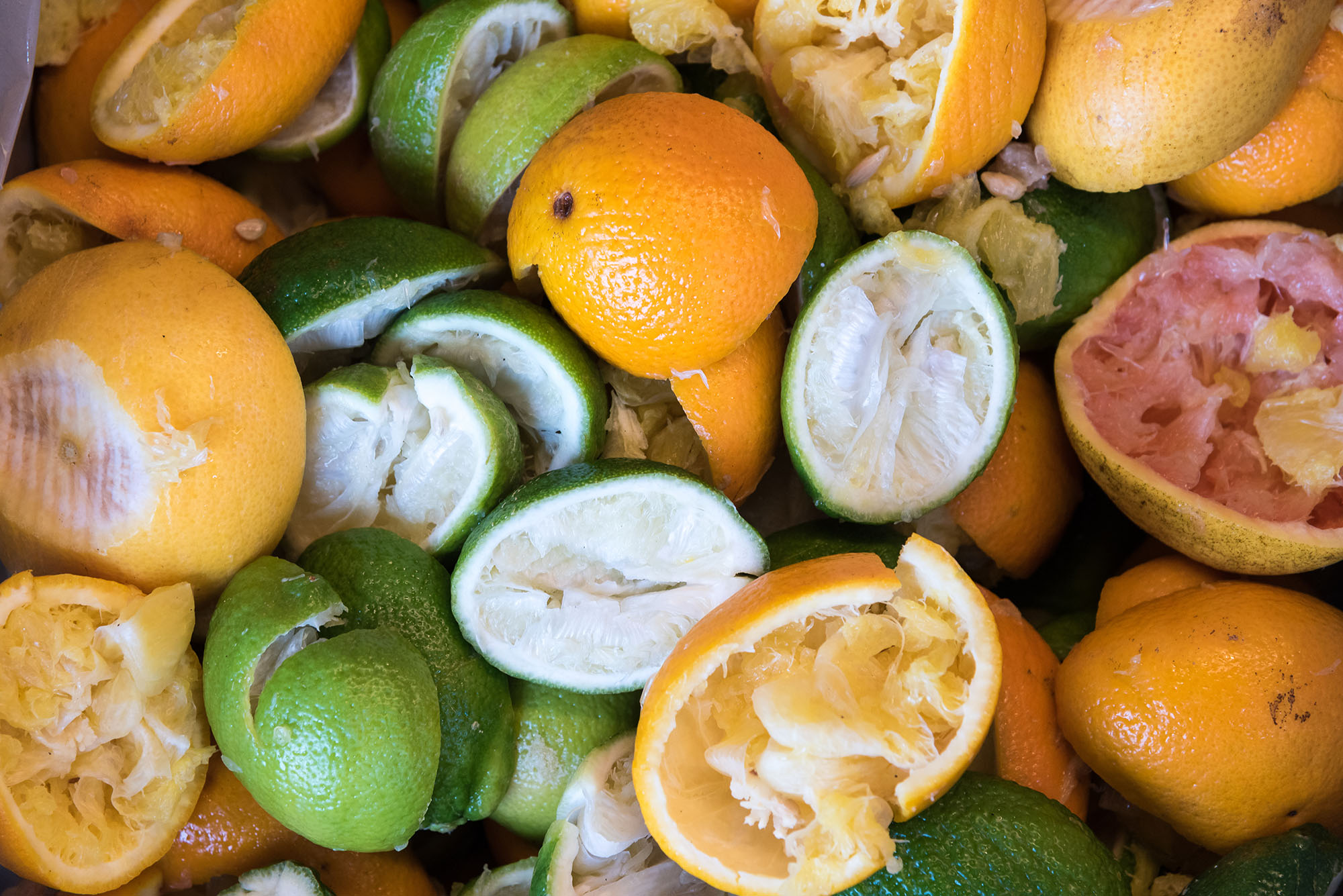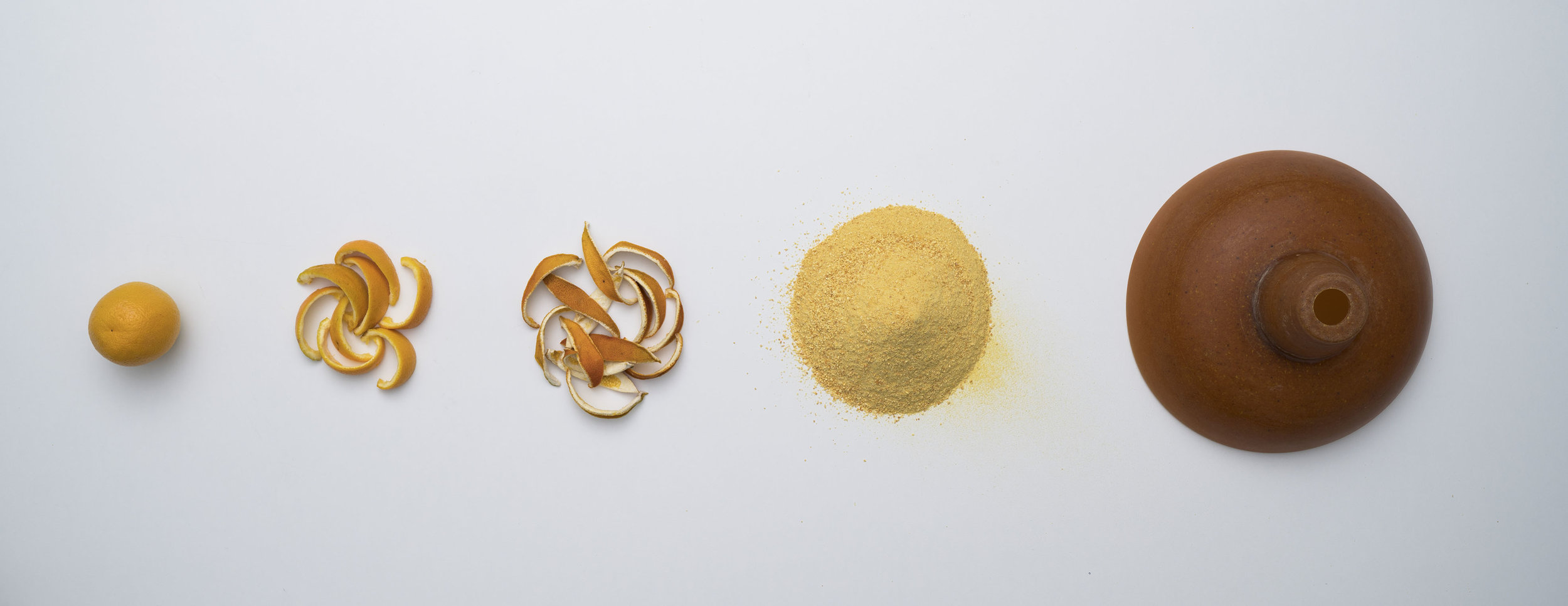The potential in an industry byproduct–The Peel Project by Venn Reactor
by Purva Chawla
Part 1: The Orange–A larger landscape
Orange Peel. Orange Pulp. Orange Peel. Orange Pulp.
There is a common ground of waste that unites both our humble consumption of oranges in homes, offices and restaurants on the one hand and the large-scale manufacture of orange products (like juice) on the other. Common to both contexts is the thoughtless disposal of peel and pulp–rich organic material–and its eventual trajectory to landfills.
But what if another future exists for the thousands of tons of this discarded, nutrient-rich material and industry waste?
In the last ten years, a handful of dramatic and diverse solutions have responded to this question. Across science, fashion, manufacturing, government, and education, innovators have envisioned and generated value from both peel and pulp.
Not too long ago, the internet was abuzz with news of an ACG site (a government managed conservation area) in Costa Rica, whose damaged soils and straggling plant life had come to a new lush life. This was all thanks to the truckloads of orange peel dumped on this site by the local Del Oro juice manufacturing plant, as agreed upon with the government.
Today, the fashion industry and brands like Salvatore Ferragamo are opening themselves up to the use of citrus fibers and fabric from companies like Orange Fiber. Spun from citrus cellulose and paste–the pulpy remains of juice production–Orange Fiber's silk-like fabric has turned industrial waste into a material worthy of high-quality fashion.
Orange peel transformed, in The Peel Project by Venn Reactor
In India last year, a team of researchers at IIT (the Indian Institute of Technology) used a pure citrus extract from orange peels to compress and recycle Polystyrene rapidly.
And finally, a new 'OPEC'–The Orange Peel Exploitation Company–was born through a collaboration between York University and investors in Spain and Brazil, led by Prof. James Clark. This initiative rests on the discovery that high-powered microwaves can break down orange peels (or other fruit peels and food) to release valuable gases. These useful gases can then be liquefied and used to create oils, cleaning chemicals, plastics, and fuels.
Part 2: A new, industrial design lens at Venn Reactor
Most of these projects have been geared towards (and have succeeded in) the extraction of valuable material from orange peel and pulp waste. In one case, orange waste was the means for an in-situ, natural re-fertilization. However, none of these projects, or others across design and manufacturing, have presented scalable innovation that highlights the inherent and existing material properties of orange peel or pulp.
Until now, that is.
Hong Kong-based industrial design consultancy Venn Reactor's work–The Peel Project–is a valuable, scalable and materially-conscious departure from this trend. Their experiments with orange peel and pulp began in a personal way–intended to digest and make sense of waste from the 700 oranges consumed each month in their office. The Peel Project began with the team wanting to see what could be achieved from this otherwise wasted raw material.
Bringing their background and strength in design-to-manufacture to the table, Venn embarked on a 3-month project which progressed rapidly from research to batch manufacture and tapped into the skills of their multidisciplinary team of designers and engineers.
During this period they generated and tested several composites, concentrations, and processes, resulting in an assortment of material samples with varying properties. They explored methods of binding the peel and pulp–among them dehydration, compression, with and without corn starch epoxy resin and home-made corn starch bioplastics, even working with just the pulp itself.
Material experimentation and testing–The Peel Project by Venn Reactor
Part 3: The Peel Project–Product and Materials Palette
One of the samples that emerged from this experimentation at Venn–a combination of orange peel and cornstarch epoxy–responded to light beautifully, resulting in a speckled orange glow.
The team at Venn decided to mold the material–which feels a little like plastic and possesses enough flexibility to prevent it from being brittle– into the shape of the iconic red Market Lamp seen in Hong Kong's wet markets. The resulting lamp is equally, if not more beautiful that it's fiery plastic counterpart. And being made of organic material, Venn's lamp biodegrades far easily.
A material sample is molded to the shape of the iconic red Market Lamp, seen in Hong Kong's wet markets. The Peel Project by Venn Reactor
A dense, grainy sample is molded to modular shapes for a stool. The Peel Project by Venn Reactor
A dense, grainy sample is molded to modular shapes for a stool. The Peel Project by Venn Reactor
Another promising material sample from the Peel Project was a dense, grainy composite with a rich citrus odor. Created with a higher concentration of the orange peel (80 %), the powdery-textured material employs less external bonding agents and can be compression molded into forms like stools and tables, as seen here. Clearly, from simple waste matter, an entire palette of materials–with unique textures, strengths, and applications–has been generated.
Ahead
The Peel Project represents an exciting example of in-house material-making by an industrial design and manufacturing entity. In it, is the promise that a new sustainable material and making process will evolve and reach the scale and complexity needed to impact the design and manufacturing industries in a meaningful way.
Also significant is the Peel Project and Venn Reactor's suggestion of industry synergies–where the byproduct of an existing industry (one that creates/consumes 3 million tons of oranges each year) can become the resource for a new line of production. All this without requiring additional energy, space or resources.
Lamp, Stool, Table and smaller product types, all generated from materials in The Peel Project by Venn Reactor.
Lamp, Stool, Table and smaller product types, all generated from materials in The Peel Project by Venn Reactor
We look forward to further developments in the Peel Project, and its impact on the industry as a whole, as a trigger for sustainable material-making and implementation at the larger, manufacturing scale.
About Venn Reactor:
Venn Reactor is an innovation supply-chain accelerator that provides research, design, engineering, and sourcing to global premium brands.
Venn Reactor specializes in the design-to-manufacture of specialty products that combine Hard materials (plastic, metals, meshes), Soft materials (textiles, vinyl, or leather), and Smart digital systems.
The vast list of clients and collaborators Venn works with includes companies like Amazon, Samsung, Google, Intel, and Toyota. They have offices in Hong Kong and San Fransisco















